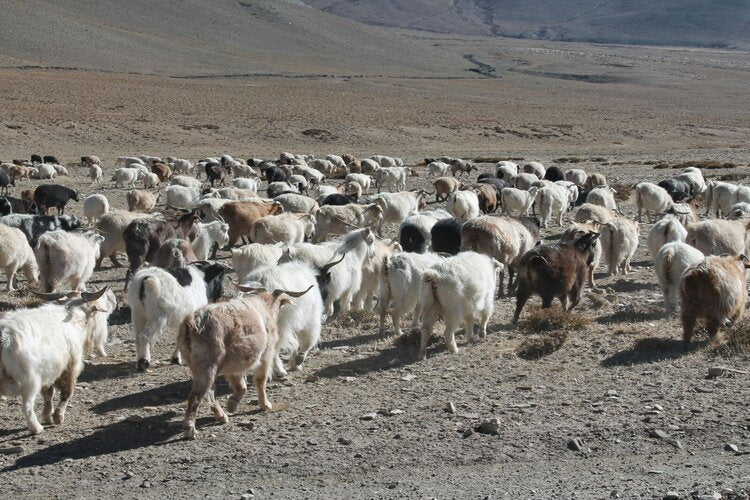What is Pashmina?
Pashmina or pashm (the Persian word for wool) refers to an ultra-refined variant of spun cashmere. Though, it’s often used to describe either the fiber itself or a style of the famed Kashmir shawl made from it. Rare and expensive, authentic pashmina originates from the Changthangi goat; a distinctive breed of Himayalan goat from Ladakh (a region in Northern India) that produces a plush, light-weight, and exceptionally warm wool that is five times finer than human hair.
Pashmina or Cashmere: Understanding the Difference
Genuine cashmere, however, is sourced directly from Ladakhi goats tended to by traditional herders in the Changthang area of Ladakh. Additionally, the actual width of the fibers collected from each type of goat is another distinguishing factor between cashmere and pashmina. Cashmere fibers have a wider diameter—making them thicker than pashmina, a much finer, thinner, and far more delicate fiber. This is why local Kashmiri artisans very carefully comb, refine, spin, weave, and embroider pashmina completely by hand.
How is Pashmina Fabric Made? The Intricate Process Behind the World’s Finest Fiber

Once the fabric is created, Kashmiri artisans use it to create lavish, original, and highly imaginative pashmina scarves, robes, shawls, blankets, clothing, and more.
Real Pashmina: Protecting the Legacy of This Ancient and Iconic Art Form
The cut-throat nature of the fast fashion industry has significantly impacted the quality of goods that are often sold as pashmina on the market today. Sacrificing quality, authenticity, and a history of five centuries of rich Kashmiri tradition—all in order to meet the growing global demand for pashmina and to maximize profits, this rabid fast fashion industry has slowly destroyed the perception of "authentic Pashmina" and over five centuries of rich, Kashmiri ancestral tradition.
Essentially, this has led many companies to make several false claims about the real origin and quality of their ‘‘so-called’’ pashmina products. So for consumers in search of the real thing, it’s crucial to be mindful about who and where you buy your pashmina from. Make sure that the brand you support is fully Kashmiri-owned, and has a strong reputation for delivering quality and authenticity. Also, take a look at how the company you’re considering educates consumers on the history of the region.
Luckily, however, there is a thriving movement of conscious-driven consumers who are creating a stable demand for authentic pashmina sourced directly from the birthplace of this famed artform, Kashmir, India.

Experience the Andraab Difference
At Andraab, we employ hundreds of highly-skilled Kashmiri weavers and embroiderers who work to the highest standards to ensure that our shawls are the epitome of quality, craftsmanship, and the spirit of Kashmir. And, we are beyond grateful to belong to a family and community of local artisans who, generation after generation, continue to inspire our vision and mission to honor the strong legacy of the elegant and illustrious Kashmir shawl.
Shop Our Collection of Luxury Pashmina Shawls
Made in Kashmir by Andraab.
Sources:
https://www.andraab.com/about
https://en.wikipedia.org/wiki/Pashmina
FEBRUARY 8, 2021

